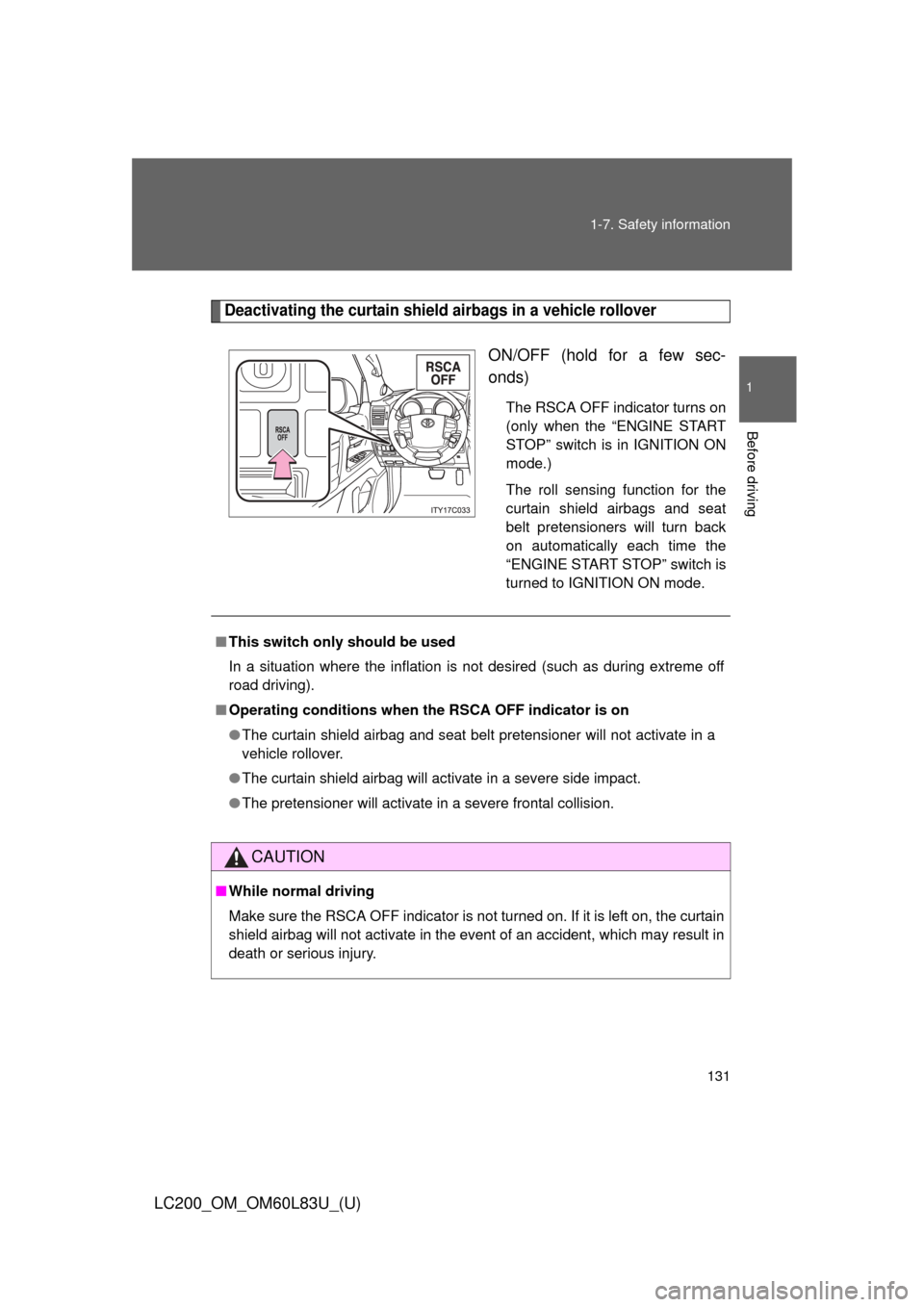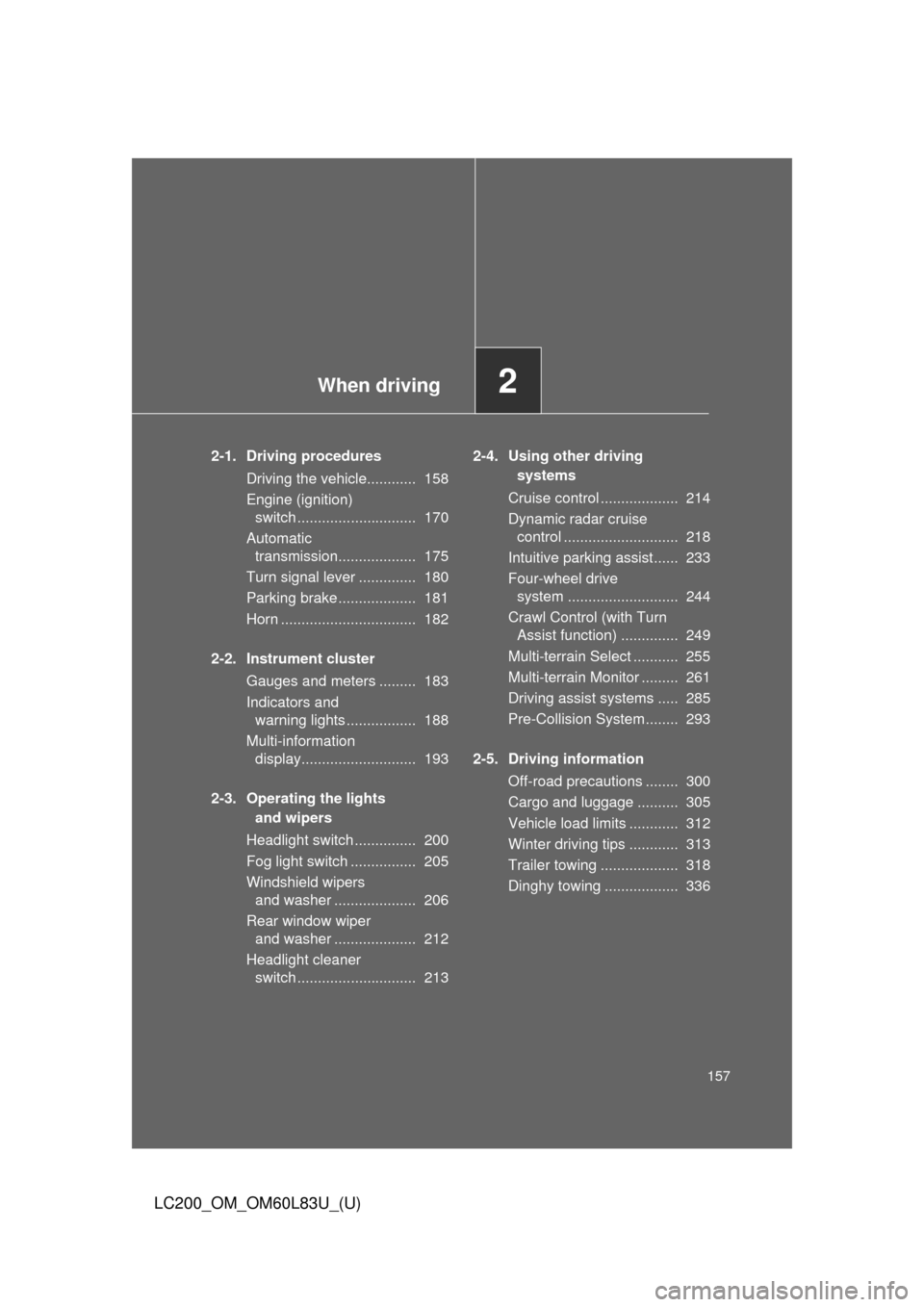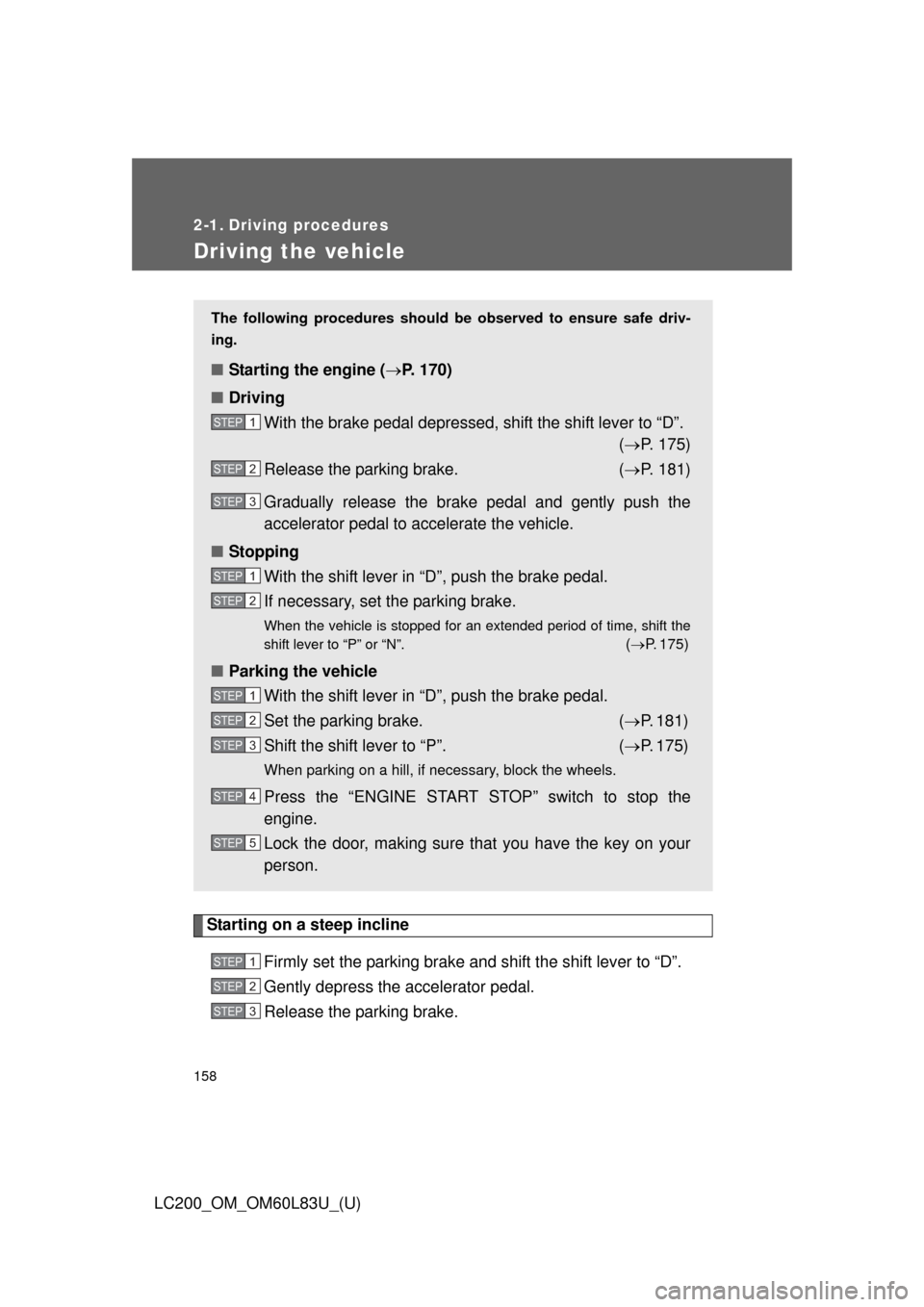Page 104 of 728
104
LC200_OM_OM60L83U_(U)
1-5. Refueling
Opening the fuel tank cap
Perform the following steps to open the fuel tank cap.
■Before refueling the vehicle
●Turn the “ENGINE START STOP” switch OFF and ensure that
all the doors and windows are closed.
● Confirm the type of fuel. ( P. 105)
■ Opening the fuel tank cap
Pull the lever.
Turn the fuel tank cap slowly
to open.
Hang the fuel tank cap on the
back of the fuel filler door.
STEP1
STEP2
STEP3
Page 108 of 728
108
LC200_OM_OM60L83U_(U)
1-6. Theft deterrent system
Engine immobilizer system
The vehicle’s keys have built-in transponder chips that prevent the
engine from starting if a key has not been previously registered in
the vehicle’s on-board computer.
Never leave the keys inside the vehicle when you leave the vehicle.
This system is designed to help prevent vehicle theft but does not
guarantee absolute security against all vehicle thefts.
Vehicles with navigation system The indicator light flashes after
the “ENGINE START STOP”
switch has been turned OFF
to indicate that the system is
operating.
The indicator light stops flash-
ing after the “ENGINE START
STOP” switch has been turned
to ACCESSORY or IGNITION
ON mode to indicate that the
system has been canceled.
Vehicles without navigation system
Page 109 of 728

109
1-6. Theft deterrent system
1
Before driving
LC200_OM_OM60L83U_(U)
■
System maintenance
The vehicle has a maintenance-free type engine immobilizer system.
■ Conditions that may cause the system to malfunction
● If the key is in contact with a metallic object.
● If the key is in close proximity to or touching a key to the security system
(key with a built-in transponder chip) of another vehicle.
■ Certifications for the engine immobilizer system
FCC ID: NI4TMIMB-1
NOTE:
This device complies with part 15 of the FCC Rules. Operation is subject to
the following two conditions: (1) This device may not cause harmful interfer-
ence, and (2) this device must accept any interference received, including
interference that may cause undesired operation.
FCC WARNING:
Changes or modifications not expressly approved by the party responsible
for compliance could void the user’s authority to operate the equipment.
CAUTION
■Certifications for the engine immobilizer system
Changes or modifications not expressly approved by the party responsible
for compliance could void the user’s authority to operate the equipment.
NOTICE
■To ensure the system operates correctly
Do not modify or remove the system. If modified or removed, the proper
operation of the system cannot be guaranteed.
Page 111 of 728
111
1-6. Theft deterrent system
1
Before driving
LC200_OM_OM60L83U_(U)
■
System maintenance
The vehicle has a maintenance-free type alarm system.
■ Items to check before locking the vehicle
To prevent unexpected triggering of the alarm and vehicle theft, make sure
of the following.
●Nobody is in the vehicle.
● The windows and moon roof are closed before the alarm is set.
● No valuables or other personal items are left in the vehicle.
■ Deactivating or stopping the alarm
Do one of the following to deactivate or stop the alarm.
●Unlock the doors.
● Turn the “ENGINE START STOP” switch to ACCESSORY or
IGNITION ON mode, or start the engine. (The alarm will be
deactivated or stopped after a few seconds.)
Page 131 of 728

131
1-7. Safety information
1
Before driving
LC200_OM_OM60L83U_(U)
Deactivating the curtain shield airbags in a vehicle rollover
ON/OFF (hold for a few sec-
onds)
The RSCA OFF indicator turns on
(only when the “ENGINE START
STOP” switch is in IGNITION ON
mode.)
The roll sensing function for the
curtain shield airbags and seat
belt pretensioners will turn back
on automatically each time the
“ENGINE START STOP” switch is
turned to IGNITION ON mode.
■
This switch only should be used
In a situation where the inflation is not desired (such as during extreme off
road driving).
■ Operating conditions when th e RSCA OFF indicator is on
● The curtain shield airbag and seat belt pretensioner will not activate in a
vehicle rollover.
● The curtain shield airbag will activate in a severe side impact.
● The pretensioner will activate in a severe frontal collision.
CAUTION
■While normal driving
Make sure the RSCA OFF indicator is not turned on. If it is left on, the curtain
shield airbag will not activate in the event of an accident, which may result in
death or serious injury.
Page 157 of 728

When driving2
157
LC200_OM_OM60L83U_(U)
2-1. Driving proceduresDriving the vehicle............ 158
Engine (ignition) switch ............................. 170
Automatic transmission................... 175
Turn signal lever .............. 180
Parking brake ................... 181
Horn ................................. 182
2-2. Instrument cluster Gauges and meters ......... 183
Indicators and warning lights ................. 188
Multi-information display............................ 193
2-3. Operating the lights and wipers
Headlight switch ............... 200
Fog light switch ................ 205
Windshield wipers and washer .................... 206
Rear window wiper and washer .................... 212
Headlight cleaner switch ............................. 213 2-4. Using other driving
systems
Cruise control ................... 214
Dynamic radar cruise control ............................ 218
Intuitive parking assist...... 233
Four-wheel drive system ........................... 244
Crawl Control (with Turn Assist function) .............. 249
Multi-terrain Select ........... 255
Multi-terrain Monitor ......... 261
Driving assist systems ..... 285
Pre-Collision System........ 293
2-5. Driving information Off-road precautions ........ 300
Cargo and luggage .......... 305
Vehicle load limits ............ 312
Winter driving tips ............ 313
Trailer towing ................... 318
Dinghy towing .................. 336
Page 158 of 728

158
LC200_OM_OM60L83U_(U)
2-1. Driving procedures
Driving the vehicle
Starting on a steep inclineFirmly set the parking brake and shift the shift lever to “D”.
Gently depress the accelerator pedal.
Release the parking brake.
The following procedures should be observed to ensure safe driv-
ing.
■ Starting the engine ( P. 170)
■ Driving
With the brake pedal depressed, shift the shift lever to “D”. ( P. 175)
Release the parking brake. ( P. 181)
Gradually release the brake pedal and gently push the
accelerator pedal to accelerate the vehicle.
■ Stopping
With the shift lever in “D”, push the brake pedal.
If necessary, set the parking brake.
When the vehicle is stopped for an extended period of time, shift the
shift lever to “P” or “N”.
(P. 175)
■ Parking the vehicle
With the shift lever in “D”, push the brake pedal.
Set the parking brake. ( P. 181)
Shift the shift lever to “P”. ( P. 175)
When parking on a hill, if necessary, block the wheels.
Press the “ENGINE START STOP” switch to stop the
engine.
Lock the door, making sure that you have the key on your
person.
STEP1
STEP2
STEP3
STEP1
STEP2
STEP1
STEP2
STEP3
STEP4
STEP5
STEP1
STEP2
STEP3
Page 159 of 728

159
2-1. Driving procedures
2
When driving
LC200_OM_OM60L83U_(U)
■
Driving in the rain
●Drive carefully when it is raining, because visibility will be reduced, the
windows may become fogged-up, and the road will be slippery.
● Drive carefully when it starts to rain, because the road surface will be
especially slippery.
● Refrain from high speeds when driving on an expressway in the rain,
because there may be a layer of water between the tires and the road
surface, preventing the steering and brakes from operating properly.
■ Engine speed while driving
In the following conditions, the engine speed may become high while driving.
This is due to automatic up-shifting control or down-shifting implementation
to meet driving conditions. It does not indicate sudden acceleration.
●The vehicle is judged to be driving uphill or downhill
● When the accelerator pedal is released
● When the brake pedal is depressed while power mode is selected
( P. 176)
■ Breaking in your new Toyota
To extend the life of the vehicle, the following precautions are recommended
to observe:
●For the first 200 miles (300 km):
Avoid sudden stops.
● For the first 500 miles (800 km):
Do not tow a trailer.
● For the first 1000 miles (1600 km):
• Do not drive at extremely high speeds.
• Avoid sudden acceleration.
• Do not drive continuously in the low gears.
• Do not drive at a constant speed for extended periods.